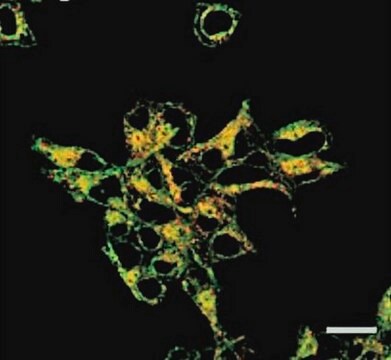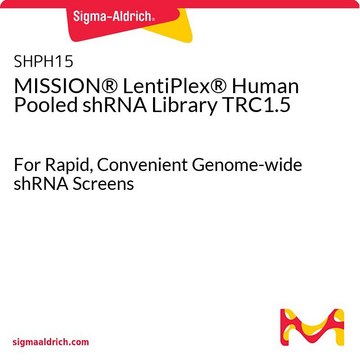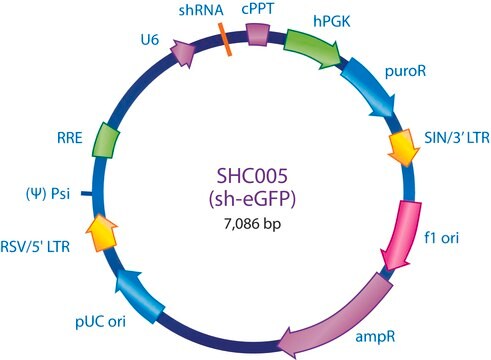Key Documents
SHPH01
MISSION® LentiPlex® Human Pooled shRNA Library
For Rapid, Convenient Genome-wide shRNA Screens
Synonim(y):
Human shRNA Library, LentiPlex shRNA Library
About This Item
Polecane produkty
Poziom jakości
linia produktu
MISSION®
stężenie
≥5x108 VP/ml (via p24 assay)
metody
capture ELISA: 5 × 108 TU/mL using p24
Warunki transportu
dry ice
temp. przechowywania
−70°C
Opis ogólny
The MISSION LentiPlex Human shRNA Pooled Library is a genome-wide lentiviral pool produced using a proprietary process. The library consists of over 75,000 shRNA constructs from the TRC collection targeting 15,000+ human genes. Each library is tested for shRNA representation before product release to ensure robust library coverage. The library is provided in ready-to-use lentiviral format at titers of at least 5 x 108 TU/ml via p24 assay and is pre-divided into ten subpools of approximately 8,000 shRNA constructs each. Amplification and sequencing primers are also provided for downstream target identification.
The library is pre-divided into ten subpools of approximately 8,000 shRNA constructs each. Each library is enough material for six screens at 100X representation.
Please visit sigma.com/lentiplex to learn more and see example data and uses.
Zastosowanie
Inne uwagi
Sigma′s deconvolution service lets you easily identify the genes that impact your pooled shRNA screen.
- Next-generation sequencing of clonesgives a precise number of individual clone occurrence within a pooled shRNA sample
- Comprehensive, reproducible results from pooled shRNA screens
- Statistically robust and information-rich data
Contact your local Sigma sales representative for more information or submit an inquiry to MISSION RNAi
Informacje prawne
produkt powiązany
wymagane, ale niedostarczone
Kod klasy składowania
12 - Non Combustible Liquids
Klasa zagrożenia wodnego (WGK)
WGK 3
Temperatura zapłonu (°F)
Not applicable
Temperatura zapłonu (°C)
Not applicable
Certyfikaty analizy (CoA)
Poszukaj Certyfikaty analizy (CoA), wpisując numer partii/serii produktów. Numery serii i partii można znaleźć na etykiecie produktu po słowach „seria” lub „partia”.
Masz już ten produkt?
Dokumenty związane z niedawno zakupionymi produktami zostały zamieszczone w Bibliotece dokumentów.
Klienci oglądali również te produkty
Produkty
Presenting an article on Pooled Lentiviral shRNA Screens to Identify Essential Cancer Pathways
Nasz zespół naukowców ma doświadczenie we wszystkich obszarach badań, w tym w naukach przyrodniczych, materiałoznawstwie, syntezie chemicznej, chromatografii, analityce i wielu innych dziedzinach.
Skontaktuj się z zespołem ds. pomocy technicznej











